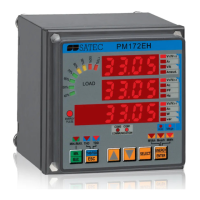27
5 DIRECT READ/WRITE REQUESTS
5.1 General
This chapter describes the instrument data locations (registers) that are addressed directly using register indexes.
These registers can be accessed by using universal direct read/write requests instead of specific ASCII requests,
which use different formats for accessing different data locations.
Data (register) indexes are given in a 4-digit hexadecimal format. All data are transmitted in ASCII hexadecimal
notation as 2-character (UINT8, 8-bit unsigned byte), 4-character (16-bit unsigned UINT16 or signed INT16
integer) or 8-character (32-bit unsigned UINT32 or signed INT32 long integer) numbers. Negative numbers are
transmitted in 2-complement code. Register type in the tables below shows an actual data size for data accessed
using variable-size direct read/write requests. When long-size direct read/write request is used, an actual data
size is ignored and all registers are transmitted in 8-character format as long signed (INT32) or unsigned
(UINT32) integers.
5.1.1 Long-Size Direct Read/Write
Table 5-1 Read Request
Message type (ASCII)
‘A’
Message body (hexadecimal)
Request
Field Offset Type Parameter Range
1 0 UINT16 Start point (register) ID to read 0x0000 - 0xFFFF
2 4 UINT8 The number of contiguous data items to read 1-30 (0x01 - 0x1E)
Response
Field Offset Type Parameter Range
1 0 UINT8 Number of data items in the message 1-30 (0x01 - 0x1E)
2 2 INT32 Data #1 value
3 10 INT32 Data #2 value
... ... ... ...
31 234 INT32 Data #30 value
Table 5-2 Write Request
Message type (ASCII)
‘a’
Message body (hexadecimal)
Request/Response
Field Offset Type Parameter Range
1 0 UINT16 Point (register) ID to write 0x0000 - 0xFFFF
2 4 INT32 Data value to write
In long-size direct read/write messages, all data items are read and written as long unsigned (UINT32) or signed
(INT32) integers, which are represented in messages by 8-digit hexadecimal numbers, regardless of the actual
data size.
By using a long-size direct read request, up to 30 contiguous parameters can be read at once. A write request
allows for writing only one data location at a time.

